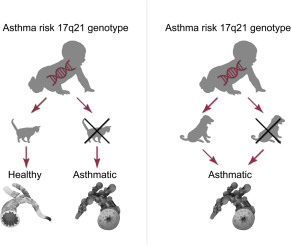Journal of Allergy and Clinical Immunology ( IF 11.4 ) Pub Date : 2017-10-25 , DOI: 10.1016/j.jaci.2017.07.044 Jakob Stokholm , Bo L. Chawes , Nadja Vissing , Klaus Bønnelykke , Hans Bisgaard

|
Background
Early-life exposure to cats and dogs has shown diverging associations with childhood asthma risk, and gene-environment interaction is one possible explanation.
Objectives
We investigated interactions between cat and dog exposure and single nucleotide polymorphism rs7216389 variants in the chromosome 17q21 locus, the strongest known genetic risk factor for childhood asthma.
Methods
Genotyping was performed in 377 children from the at-risk Copenhagen Prospective Studies on Asthma in Childhood2000. The primary end point was the development of asthma until age 12 years. The secondary end point was the number of episodes with pneumonia and bronchiolitis from 0 to 3 years of age. Exposures included cat and dog ownership from birth and cat and dog allergen levels in bedding at age 1 year. Replication was performed in the unselected COPSAC2010 cohort with follow-up until 5 years of age.
Results
Cat and/or dog exposure from birth was associated with a lower prevalence of asthma among children with the rs7216389 high-risk TT genotype (adjusted hazard ratio, 0.16; 95% CI, 0.04-0.71; P = .015), with no effect in those with the CC/CT genotype (adjusted P = .283), demonstrating interaction between cat and dog exposure and the rs7216389 genotype (adjusted P = .044). Cat allergen levels were inversely associated with asthma development in children with the TT genotype (adjusted hazard ratio, 0.83; 95% CI, 0.71-0.97; P = .022), supporting the cat–rs7216389 genotype interaction (adjusted P = .008). Dog allergen exposure did not show such interaction. Furthermore, the TT genotype was associated with higher risk of pneumonia and bronchiolitis, and this increased risk was likewise decreased in children exposed to cat. Replication showed similar effects on asthma risk.
Conclusion
The observed gene-environment interaction suggests a role of early-life exposure, especially to cat, for attenuating the risk of childhood asthma, pneumonia, and bronchiolitis in genetically susceptible subjects.
中文翻译:

早期接触猫会降低17q21高风险变种的哮喘风险
背景
早期接触猫和狗已显示出与儿童哮喘风险的不同关联,而基因与环境的相互作用是一种可能的解释。
目标
我们研究了猫和狗暴露与17q21染色体位点中单核苷酸多态性rs7216389变体之间的相互作用,该位点是儿童哮喘的最强已知遗传危险因素。
方法
基因型分型是在377名危险的哥本哈根2000年儿童哮喘研究中进行的。主要终点是直到12岁之前哮喘的发展。次要终点是0到3岁之间的肺炎和细支气管炎发作次数。暴露包括出生时猫和狗的所有权以及1岁时床上用品中猫和狗的过敏原水平。在未选择的COPSAC 2010队列中进行复制,并随访至5岁。
结果
rs7216389高风险TT基因型儿童的出生后暴露于猫和/或狗与哮喘的患病率较低(风险比经调整为0.16; 95%CI为0.04-0.71; P = .015)无影响在那些与CC / CT基因型(调整P = 0.283),这表明猫,狗曝光和rs7216389基因型之间的相互作用(调整P = 0.044)。TT基因型儿童的猫过敏原水平与哮喘的发展呈负相关(调整后的危险比,0.83; 95%CI,0.71-0.97;P = .022),支持了cat-rs7216389基因型的相互作用(调整后的P = .008)。狗过敏原暴露没有显示出这种相互作用。此外,TT基因型与患肺炎和细支气管炎的风险较高有关,而暴露于猫的儿童中这种风险的增加也有所降低。复制显示出对哮喘风险的类似作用。
结论
观察到的基因与环境之间的相互作用表明,早期暴露,尤其是对猫的暴露,对于减轻遗传易感人群中儿童哮喘,肺炎和细支气管炎的风险具有重要作用。











































 京公网安备 11010802027423号
京公网安备 11010802027423号